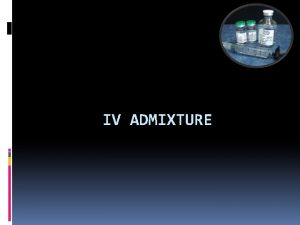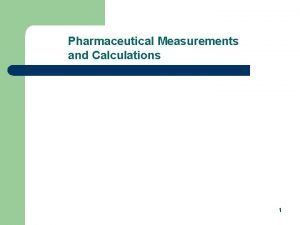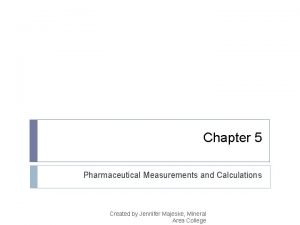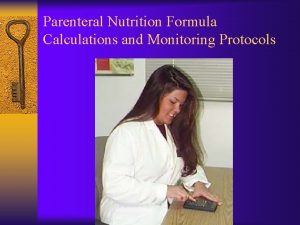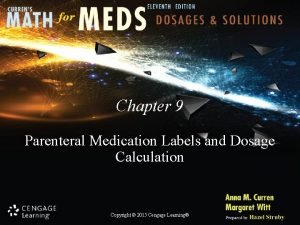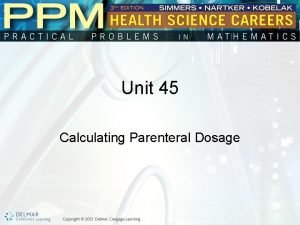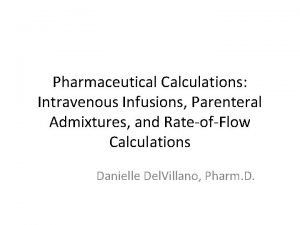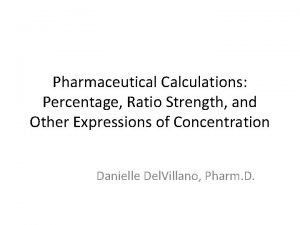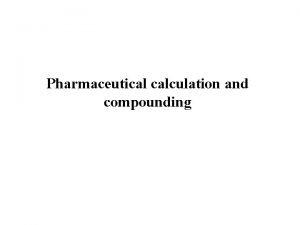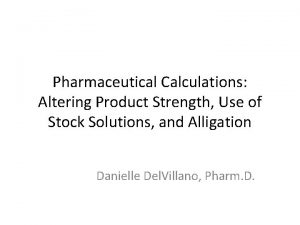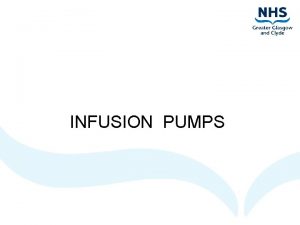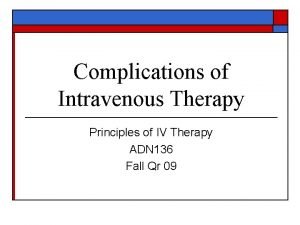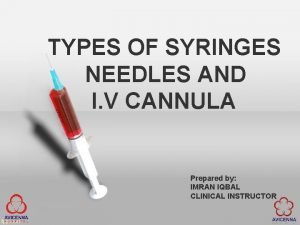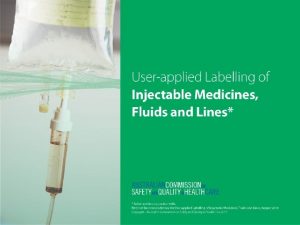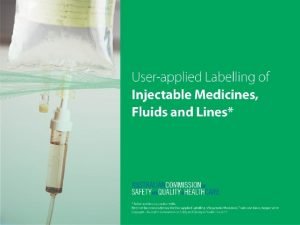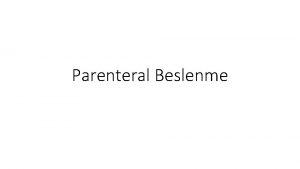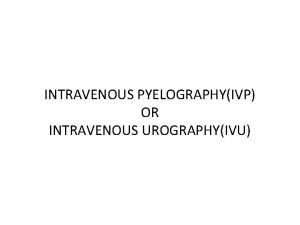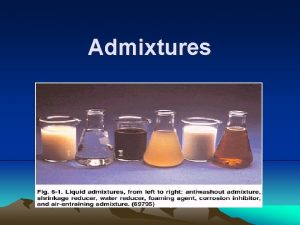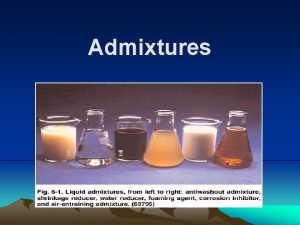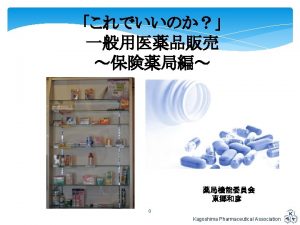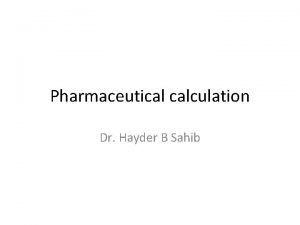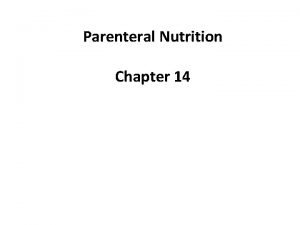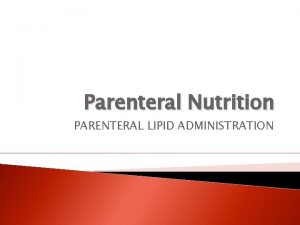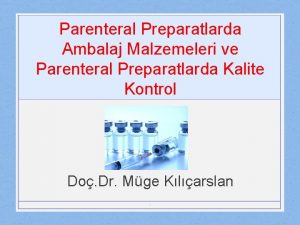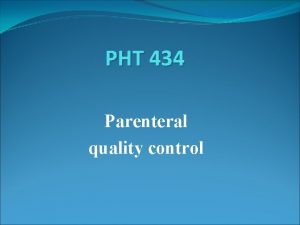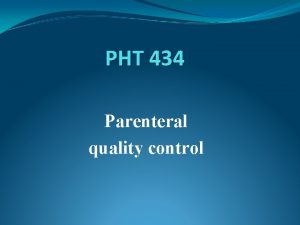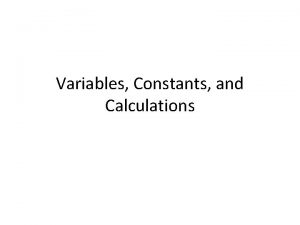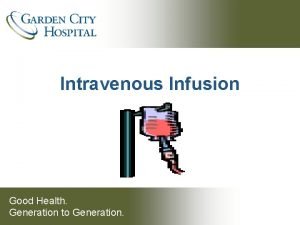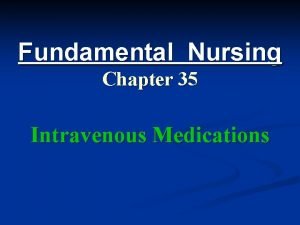Pharmaceutical Calculations Intravenous Infusions Parenteral Admixtures and RateofFlow

























- Slides: 25

Pharmaceutical Calculations: Intravenous Infusions, Parenteral Admixtures, and Rate-of-Flow Calculations Danielle Del. Villano, Pharm. D.

Objectives • Perform calculations for the adult and pediatric intravenous infusions • Perform calculations for intravenous additives • Perform rate-of-flow calculations for intravenous fluids

Introduction • Injections – Intravenous, intramuscular, intradermal • Parenteral administration – Anything other than enteral route • Intravenous infusions – IVPB, IV push, large volume parenteral • Administration set – Certain number of drops per m. L

Problem 1 • How many grams of dextrose and sodium chloride are used to prepare a 250 m. L bag of D 51/2 NS for intravenous infusion? 250 m. L * 0. 05 = 12. 5 g dextrose 250 m. L * 0. 0045 = 1. 125 g sodium chloride

Problem 2 • A physician orders enalaprilat (Vasotec IV) 2 mg IVP for a hypertensive patient. A pharmacist delivers several 1 m. L injections, each containing 1. 25 mg enalaprilat. How many m. L of the injection should be administered? 1. 25 mg = 2 mg 1 m. L x = 1. 6 m. L

Problem 3 • Calculate the daily infusion volume of D 10 W to be administered to a neonate weighing 3 lb 8 oz on the basis of 60 m. L/kg/day. 3 lb 8 oz --> 3. 5 lbs = 1. 6 kg 2. 2 60 m. L/kg/day* 1. 6 kg = 96 m. L/day

Problem 4 • An intravenous infusion is to contain 15 m. Eq of potassium ion and 20 m. Eq of sodium ion in 500 m. L D 5 W. Using potassium chloride containing 6 g/30 m. L and 0. 9% NS injection, how many milliliters of each should be used to supply the required ions? KCl Na. Cl 1 m. Eq = 74. 5 mg 1 m. Eq = 58. 5 mg 15 m. Eq x mg 20 m. Eq x mg x = 1118 mg x = 1170 mg 6 g = 1. 118 g 0. 9 g = 1. 17 g 30 m. L x m. L 100 m. L x = 5. 6 m. L x = 130 m. L

Rate of Flow Equations • Rate (drops/min) = Vol (m. L) * dripset (drop/m. L) Time (min) • Infusion time = Vol (m. L) Rate (m. L/min)

Problem 5 • A medication order calls for 1000 m. L of D 5 W to be administered over an 8 hour period. Using an IV administration set that delivers 10 drops/m. L, how many drops per minute should be delivered to the patient? Rate = 1000 m. L * 10 drops/m. L (8 hr * 60 min/hr) Rate = 20. 8 or 21 drops/min

Problem 6 • An intravenous infusion contains 10 m. L of a 1: 5000 solution of isoproterenol hydrochloride and 500 m. L of a 5% dextrose injection. At what flow rate should the infusion be administered to provide 5 mcg of isoproterenol hydrochloride per minute, and what time interval will be necessary for the administration of the entire infusion?

Problem 6 1 g 5000 m. L x = xg 10 m. L =. 002 g = 2 mg 2000 mcg = 5 mcg 510 m. L x = 1. 28 m. L per minute 1. 28 m. L 1 min x = 510 m. L x min = 398 minutes, or ~6. 5 hours

Questions

Reference • Ansel, H. C. (2009) Phamaceutical Calculations (13 th Ed. ). Philadelphia: Lippincott Williams & Wilkins, and Wolters Kluwer Publishers

Additional Problems

Chapter 13 Page 219 • A physician prescribes amiodarone HCl IV (Cordarone) for a patient with ventricular fibrillation. The prescribing information is – Loading infusion • Rapid infusion over first 10 min • Slow infusion over the next 6 hours 15 mg/min 1 mg/min • Slow infusion over the remaining 18 hours 0. 5 mg/min – Maintenance infusion • Amiodarone HCl IV is available in 3 m. L ampuls containing 50 mg/m. L. The pharmacist uses a 100 m. L bag of D 5 W for the rapid infusion and 250 m. L bottles of D 5 W for the slow infusion.

Chapter 13 Page 219 • How many milliliters from an amiodarone HCl IV ampul should be placed in the 100 m. L bag for the rapid infusion? • What is the drug concentration in the rapid infusion, in mg/m. L?

Chapter 13 Page 219 • If the pharmacist added the contents of 3 ampuls to each 250 m. L bottle of D 5 W needed for the slow infusions, calculate the drug concentration in mg/m. L • What rate of administration, in m. L/hr, should the pharmacist have recommended during the 6 hour infusion segment?

Chapter 13 Page 219 • Calculate the rate of administration in the last question in drops/minute with an administration set that delivers 15 drops/m. L • Calculate the milligrams of drug administered by slow infusion over the 6 hour segment

Chapter 13 Page 219 • Make the same calculation as in the last question but over the 18 hour segment

Chapter 13 Problem 3 • A patient received 250 m. L of an infusion at a rate of 40 m. L/hr. What was the total infusion time in hours and minutes?

Chapter 13 Problem 9 • An emergency syringe contains lidocaine, 1 g/5 m. L. How many milliliters should be used in preparing 250 m. L of an infusion to contain 4 mg/m. L of lidocaine in D 5 W?

Chapter 13 Problem 13 • A pharmacist receives a medication order for 300, 000 units of penicillin G potassium to be added to 500 m. L of D 5 W. The directions on the 1, 000 -unit vial state that if 1. 6 m. L of solvent are added, the solution will measure 2 m. L. How many milliliters of the solution must be withdrawn and added to the D 5 W?

Chapter 13 Problem 21 • How many milliliters of an injection containing 1 g of drug in 4 m. L should be used in filling a medication order requiring 275 mg of the drug to be added to 500 m. L of D 5 W solution? If the solution is administered at the rate of 1. 6 m. L per minute, how many milligrams of the drug will the patient receive in 1 hour?

Chapter 13 Problem 31 • If a physician orders 5 units of insulin to be added to a 1 -liter intravenous solution of D 5 W to be administered over 8 hours, (a) how many drops per minute should be administered using an IV set that delivers 15 drops/m. L, and (b) how many units of insulin would be administered in each 30 -minute period?

Chapter 13 Problem 48 • CARDENE IV (nicardipine hydrochloride) is administered in the short-term treatment of hypertension by slow intravenous infusion at a concentration of 0. 1 mg/m. L. A 10 -m. L ampule containing 25 mg of nicardipine hydrochloride should be added to what volume of D 5 W to achieve the desired concentration of infusion? – (a) 80 m. L – (b) 100 m. L – (c) 240 m. L – (d) 250 m. L
 Parenteral admixture
Parenteral admixture Pharmaceutical measurements and calculations
Pharmaceutical measurements and calculations Pharmaceutical measurements
Pharmaceutical measurements Parenteral nutrition calculations
Parenteral nutrition calculations Bolus plural
Bolus plural Parenteral dosage calculator
Parenteral dosage calculator Parenteral calculations
Parenteral calculations How to calculate percentage strength
How to calculate percentage strength Pharmaceutical compounding calculations
Pharmaceutical compounding calculations Ointment calculations
Ointment calculations Structural steel connection calculations calculations
Structural steel connection calculations calculations Particulate contamination in infusions
Particulate contamination in infusions What are infusions
What are infusions Pipeed
Pipeed Concrete admixtures
Concrete admixtures Concrete admixtures
Concrete admixtures Astm c 1644
Astm c 1644 Admixtures
Admixtures Concrete admixtures nno disperant
Concrete admixtures nno disperant Injectable medication administration pretest
Injectable medication administration pretest Iv placement sites
Iv placement sites Complications of iv
Complications of iv Medication administration 3 pretest
Medication administration 3 pretest Types of cannula and size
Types of cannula and size Line & catheter label - intravenous burette
Line & catheter label - intravenous burette Line & catheter label - intravenous burette
Line & catheter label - intravenous burette
